217 posts
Latest Posts by paranoid0peach - Page 2
List of things I wished they would've included in Turn
-John Laurens -Lafayette sucking at dancing -Lafayette crying at John Andre’s hanging and Hamilton trying to defend John Andre by saying he’s too beautiful to be hanged -Flashbacks of Ben and Nathan -Lafayette and George taking a nap after the battle of Monmouth -the duel between John Laurens and Charles Lee -Baron von Steuben -the fucking way Baron von Steuben came into the fucking camp like some sort of god -Baron von Steuben falling in love with Benjamin Walker -FLASHBACKS OF BEN AND NATHAN -the time everyone thought Hamilton died and then he stood in the doorway dripping wet -Scenes with Lafayette, Hamilton and Laurens doing things that actually happened like pushing their beds together or spending whole nights on the grass outside and just talking about politics -just the three of them being besties -JOHN LAURENS!!!!
I mean there are obviously more things and probably more important things but this the stuff they easily could have included on the show.














Lunar Eclipse 2019
Please don’t delete the link to the photographers/artists, thanks!


follow for more constellations and other 8bit space art!




Mars - Moon - Saturn - Jupiter - Venus (Aug. 22, 2018)
10 Things: Why Cassini Mattered
One year ago, on Sept. 15, 2017, NASA’s Cassini spacecraft ended its epic exploration of Saturn with a planned dive into the planet’s atmosphere–sending back new science to the last second. The spacecraft is gone, but the science continues. Here are 10 reasons why Cassini mattered…

1. Game Changers
Cassini and ESA (European Space Agency)’s Huygens probe expanded our understanding of the kinds of worlds where life might exist.

2. A (Little) Like Home
At Saturn’s largest moon, Titan, Cassini and Huygens showed us one of the most Earth-like worlds we’ve ever encountered, with weather, climate and geology that provide new ways to understand our home planet.

3. A Time Machine (In a Sense)
Cassini gave us a portal to see the physical processes that likely shaped the development of our solar system, as well as planetary systems around other stars.

4. The Long Run
The length of Cassini’s mission enabled us to observe weather and seasonal changes over nearly half of a Saturn year, improving our understanding of similar processes at Earth, and potentially those at planets around other stars.

5. Big Science in Small Places
Cassini revealed Saturn’s moons to be unique worlds with their own stories to tell.

6. Ringscape
Cassini showed us the complexity of Saturn’s rings and the dramatic processes operating within them.

7. Pure Exploration
Some of Cassini’s best discoveries were serendipitous. What Cassini found at Saturn prompted scientists to rethink their understanding of the solar system.

8. The Right Tools for the Job
Cassini represented a staggering achievement of human and technical complexity, finding innovative ways to use the spacecraft and its instruments, and paving the way for future missions to explore our solar system.

9. Jewel of the Solar System
Cassini revealed the beauty of Saturn, its rings and moons, inspiring our sense of wonder and enriching our sense of place in the cosmos.

10. Much Still to Teach Us
The data returned by Cassini during its 13 years at Saturn will continue to be studied for decades, and many new discoveries are undoubtedly waiting to be revealed. To keep pace with what’s to come, we’ve created a new home for the mission–and its spectacular images–at https://solarsystem.nasa.gov/cassini.
Make sure to follow us on Tumblr for your regular dose of space: http://nasa.tumblr.com.
Greatest Hits — Craters We Love
Our solar system was built on impacts — some big, some small — some fast, some slow. This week, in honor of a possible newly-discovered large crater here on Earth, here’s a quick run through of some of the more intriguing impacts across our solar system.
1. Mercury: A Basin Bigger Than Texas

Mercury does not have a thick atmosphere to protect it from space debris. The small planet is riddled with craters, but none as spectacular as the Caloris Basin. “Basin” is what geologists call craters larger than about 186 miles (300 kilometers) in diameter. Caloris is about 950 miles (1,525 kilometers) across and is ringed by mile-high mountains.
For scale, the state of Texas is 773 miles (1,244 kilometers) wide from east to west.
2. Venus: Tough on Space Rocks

Venus’ ultra-thick atmosphere finishes off most meteors before they reach the surface. The planet’s volcanic history has erased many of its craters, but like almost any place with solid ground in our solar system, there are still impact scars to be found. Most of what we know of Venus’ craters comes from radar images provided by orbiting spacecraft, such as NASA’s Magellan.
Mead Crater is the largest known impact site on Venus. It is about 170 miles (275 kilometers) in diameter. The relatively-flat, brighter inner floor of the crater indicates it was filled with impact melt and/or lava.
3. Earth: Still Craters After All These Years

Evidence of really big impacts — such as Arizona’s Meteor Crater — are harder to find on Earth. The impact history of our home world has largely been erased by weather and water or buried under lava, rock or ice. Nonetheless, we still find new giant craters occasionally.
A NASA glaciologist has discovered a possible impact crater buried under more than a mile of ice in northwest Greenland.
This follows the finding, announced in November 2018, of a 19-mile (31-kilometer) wide crater beneath Hiawatha Glacier – the first meteorite impact crater ever discovered under Earth’s ice sheets.
If the second crater, which has a width of over 22 miles (35 kilometers), is ultimately confirmed as the result of a meteorite impact, it will be the 22nd largest impact crater found on Earth.
4. Moon: Our Cratered Companion

Want to imagine what Earth might look like without its protective atmosphere, weather, water and other crater-erasing features? Look up at the Moon. The Moon’s pockmarked face offers what may be humanity’s most familiar view of impact craters.
One of the easiest to spot is Tycho, the tight circle and bright, radiating splat are easy slightly off center on the lower-left side of the full moon. Closer views of the 53-mile (85 kilometer)-wide crater from orbiting spacecraft reveal a beautiful central peak, topped with an intriguing boulder that would fill about half of a typical city block.
5. Mars: Still Taking Hits

Mars has just enough atmosphere to ensure nail-biting spacecraft landings, but not enough to prevent regular hits from falling space rocks. This dark splat on the Martian south pole is less than a year old, having formed between July and September 2018. The two-toned blast pattern tells a geologic story. The larger, lighter-colored blast pattern could be the result of scouring by winds from the impact shockwave on ice. The darker-colored inner blast pattern is because the impactor penetrated the thin ice layer, blasting the dark sand underneath in all directions.
6. Ceres: What Lies Beneath

The bright spots in Ceres’ Occator crater intrigued the world from the moment the approaching Dawn spacecraft first photographed it in 2015. Closer inspection from orbit revealed the spots to be the most visible example of hundreds of bright, salty deposits that decorate the dwarf planet like a smattering of diamonds. The science behind these bright spots is even more compelling: they are mainly sodium carbonate and ammonium chloride that somehow made their way to the surface in a slushy brine from within or below the crust. Thanks to Dawn, scientists have a better sense of how these reflective areas formed and changed over time — processes indicative of an active, evolving world.
7. Comet Tempel 1: We Did It!

Scientists have long known we can learn a lot from impact craters — so, in 2005, they made one themselves and watched it happen.
On July 4, 2005, NASA’s Deep Impact spacecraft trained its instruments on an 816-pound (370-kilogram) copper impactor as it smashed into comet Tempel 1.
One of the more surprising findings: The comet has a loose, “fluffy” structure, held together by gravity and contains a surprising amount of organic compounds that are part of the basic building blocks of life.
8. Mimas: May the 4th Be With You

Few Star Wars fans — us included — can resist Obi Wan Kenobi’s memorable line “That’s no moon…” when images of Saturn’s moon Mimas pop up on a screen. Despite its Death Star-like appearance, Mimas is most definitely a moon. Our Cassini spacecraft checked, a lot — and the superlaser-looking depression is simply an 81-mile (130-kilometer) wide crater named for the moon’s discoverer, William Herschel.
9. Europa: Say What?

The Welsh name of this crater on Jupiter’s ocean moon Europa looks like a tongue-twister, but it is easiest pronounced as “pool.” Pwyll is thought to be one of the youngest features we know of on Europa. The bright splat from the impact extends more than 600 miles (about 1,000 kilometers) around the crater, a fresh blanket over rugged, older terrain. “Fresh,” or young, is a relative term in geology; the crater and its rays are likely millions of years old.
10. Show Us Your Greatest Hits

Got a passion for Stickney, the dominant bowl-shaped crater on one end of Mars’ moon Phobos? Or a fondness for the sponge-like abundance of impacts on Saturn’s battered moon Hyperion (pictured)? There are countless craters to choose from. Share your favorites with us on Twitter, Instagram and Facebook.
Make sure to follow us on Tumblr for your regular dose of space: http://nasa.tumblr.com
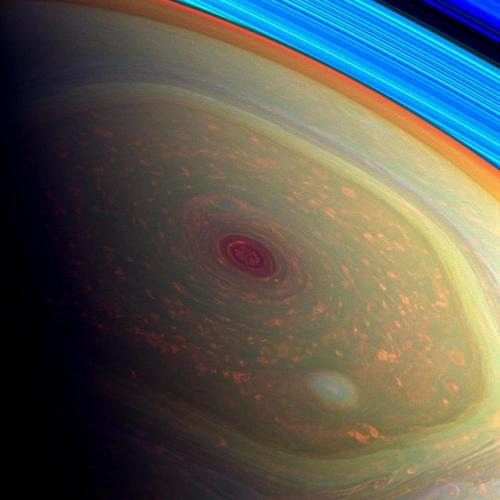
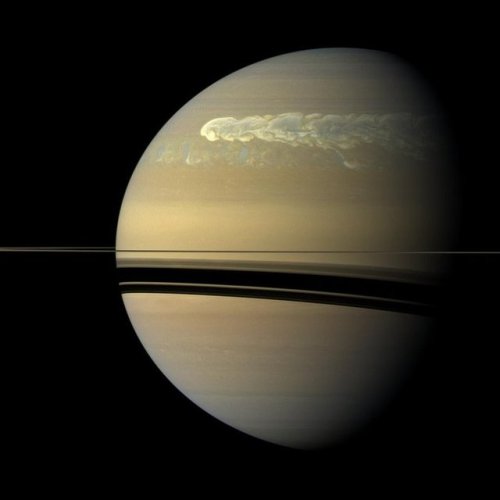
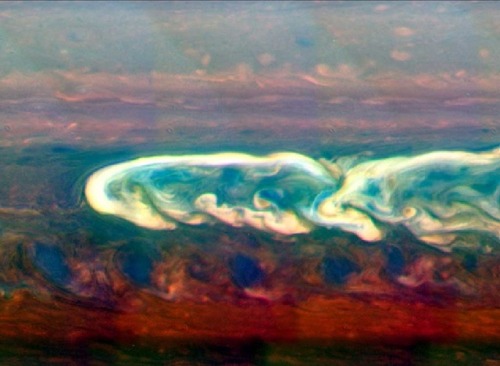



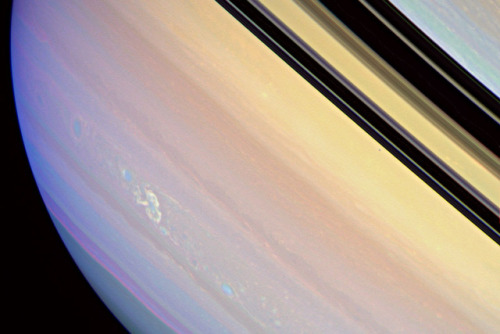

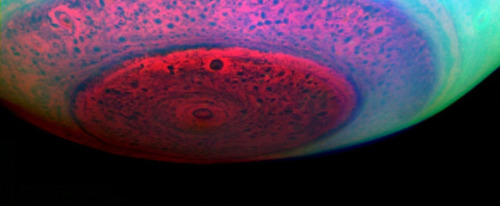
Saturn’s atmosphere exhibits a banded pattern similar to Jupiter’s, but Saturn’s bands are much fainter and are much wider near the equator. The nomenclature used to describe these bands is the same as on Jupiter. Saturn’s finer cloud patterns were not observed until the flybys of the Voyager spacecraft during the 1980s. Since then, Earth-based telescopy has improved to the point where regular observations can be made. The composition of the clouds varies with depth and increasing pressure.
The winds on Saturn are the second fastest among the Solar System’s planets, after Neptune’s. Voyager data indicate peak easterly winds of 500 m/s (1,800 km/h).
Thermography has shown that Saturn’s south pole has a warm polar vortex, the only known example of such a phenomenon in the Solar System. Whereas temperatures on Saturn are normally −185 °C, temperatures on the vortex often reach as high as −122 °C, suspected to be the warmest spot on Saturn.
Credit: NASA/JPL-Caltech/Space Science Institute and Kevin M. Gill


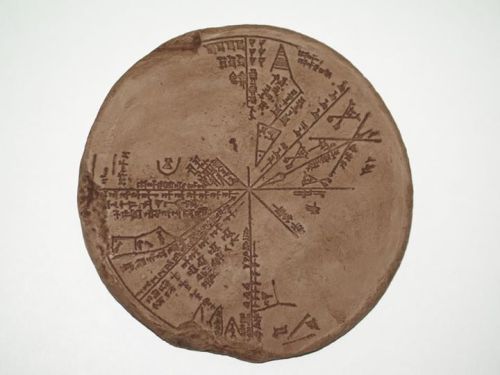
The Sky Map of Ancient Nineveh, 3300 B.C.
The origins of Western astronomy can be found in Mesopotamia, and all Western efforts in the exact sciences are descendants in direct line from the work of the late Babylonian astronomers. This circular cuneiform tablet is a reproduction after a Sumerian star map, which perfectly matches the sky above Mesopotamia, in 3300 B.C.
It is an astrolabe, one of the oldest tools used for locating and predicting the positions of the Sun, Moon, planets, and stars. Some call this the Sodom and Gomorrah Tablet because it describes a comet/asteroid which some think destroyed Sodoma and Gomorrah around 3300 B.C.




Jupiter has 12 newly discovered moons!! I really relate to Valetudo, for some reason…

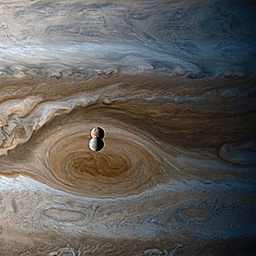
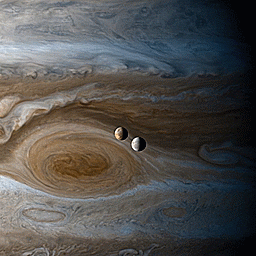
Created using still images taken by the Cassini spacecraft during it’s flyby of Jupiter and while at Saturn. Shown is Io and Europa over Jupiter’s Great Red Spot.
NASA/JPL-Caltech/SSI/CICLOPS/Kevin M. Gill
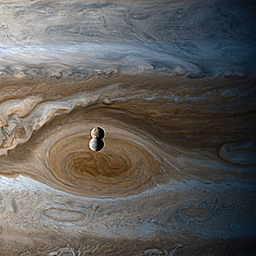
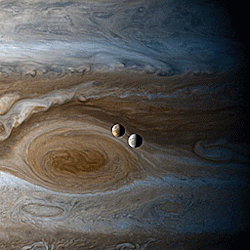
Timelapse of Europa & Io orbiting Jupiter, shot from Cassini during its flyby of Jupiter

“Drapery Studies”, c. 1545
By: MICHELANGELO….

Is that you David?

Two of my favorite pieces of art
(My first favorite is The Last Supper)

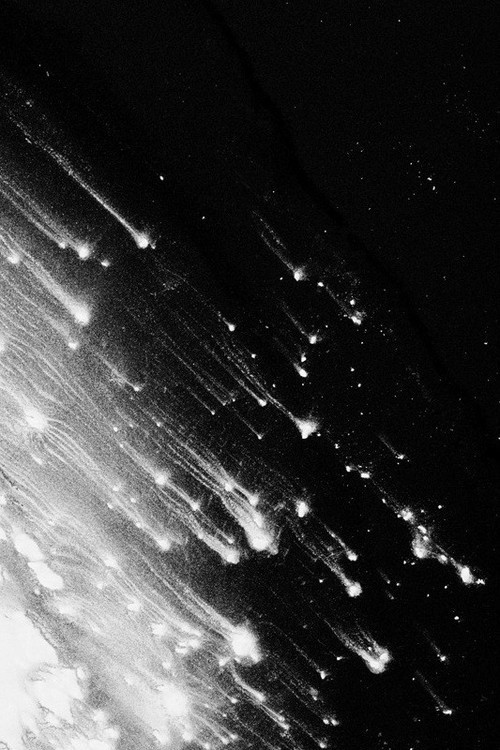
Sonata In G Minor For Violin & Piano, L.140 - I. Allegro Vivo
By Composer Claude Debussy
Joshua Bell, Violinist ~ Jean-Yves Thibaudet, Pianist
Artwork : “Falling Petals” By Artist Daniel F. Gerhartz
Suite Bergamasque, CD 82 ; L.75 - IV. Passepied (Orchestral)
By Composer Claude Debussy
Performed By The San Francisco Ballet Orchestra

Claude Debussy with Erik Satie, in the Avenue du Bois de Boulogne, Paris (Debussy’s home) in 1910.
Debussy plays Debussy - 1913
Claude Debussy plays La soirée dan Grenade, 1913
(Welte Mignon recording)
What a beautiful song.
2 Romances, CD.65, L.79, Arranged For Violin and Piano : I. L'âme évaporée (1891)
By Composer Claude Debussy
Performed By Duo Tolkien : Alessio Benvenuti, Violin ~ Marco Lo Muscio, Piano
L'âme évaporée et souffrante
The vanishing and suffering soul, the sweet soul, the fragrant soul of divine lilies that I have picked In the garden of your thoughts, Where, then, have the winds chased it, this charming soul of the lilies ? Is there no longer a perfume that remains of the celestial sweetness of the days when you enveloped me In a supernatural haze, made of hope, of faithful love, of bliss and of peace ?